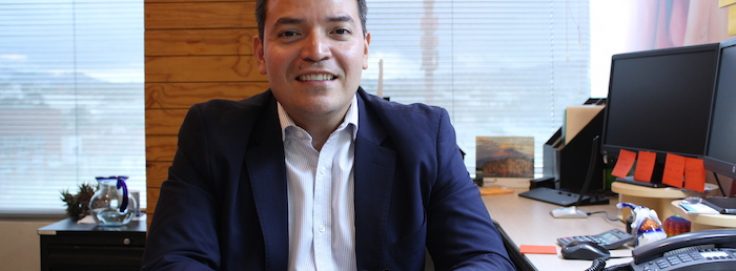
Search
Jimmy Vásquez: ‘Multidimensional poverty measurement allows the state to see things which income measurement does not show’

The MPI of El Salvador (MPI-ES) was launched in 2015 after a broad participatory process that involved academics, politicians, and people living in poverty. We spoke to Jimmy Vásquez, who was on the team that led the process for creating the MPI-ES.
Why did El Salvador decide to measure poverty in a multidimensional way?
It was for a number of reasons. In short, I think that in El Salvador we came to the conclusion that income poverty measurement was not proving to be very useful for guiding the implementation of public policy interventions, especially with regards to social policy.
At the beginning of 2000, different studies, particularly several that were carried out by the agencies of the United Nations System (UNS), indicated that income poverty was not being adequately measured. The fundamental reason for this was that the reference for the basic food basket, which was established in 1983 and is still used, was based on nutritional patterns observed in urban and rural areas of the country in 1967 and 1976, respectively. Obviously, 40 years later, this is very different. Consumption patterns have changed, due to, among other reasons, the growing weight of international remittances on the economy (around 17% of the GDP) and its effect on household consumption.
Furthermore, since 2005 accountability and the communication of the results of income poverty rates, became, let us say, uncomfortable. The indicator began to show significant volatility in spite of the implementation of the first conditional transfer programmes. What was behind this? Because El Salvador is a small economy, a price taker in world markets, what happened was that poverty began to show behaviour akin to nutritional inflation and inflation of the basic components of the basic food basket, in particular with regard to the price of corn and beans, and a weak or almost null relationship with the behaviour of household income.
Jimmy Vásquez, Salvadoran economist, led the technical-political process of establishing and formalising multidimensional poverty measurement in El Salvador. He is the author of the book Poverty in El Salvador from the Perspective of its Protagonists and co-author of the UNDP report Multidimensional Progress: Well-being Beyond Income. He is currently a specialist in social policy for UNICEF El Salvador.
Meanwhile, although the official poverty measure used the income approach, social programmes and their conceptualisation, as reflected in the poverty maps of the time, were based on a multidimensional understanding of the phenomenon. However, there had not yet been a move towards a rigorous process that would allow for the creation of a methodology that would measure poverty periodically in a multidimensional way. It is in this context that the opportunity arose and the decision to move towards this approach was taken.
How did the process begin?
In the beginning it coincided with the process in Mexico which led to the adoption of the multidimensional poverty methodology there in December 2009. In El Salvador the timing was ideal to set in motion a similar project, which was developed by the UNS with the financial support of the Grand Duchy of Luxembourg. That gave birth to a formal project, with large funding, which allowed for the evaluation of the successes and failures of the project in Mexico, based on the understanding that we were looking for the most efficient route for the political adoption of this process.
The starting point was defined by two moments. The first was the establishment of a political advisory body called the Advisory Council on Multidimensional Poverty, which was made up of experts in the county and co-directed by the UNS and the Technical and Planning Secretariat of the Presidency. A technical advisory body was set up in parallel to this. These councils had the task of supporting the process both at the political and technical level, as well as making vital decisions about the methodology – for example, which dimensions to include and what the minimum achievement would be in a determined indicator to consider a person or household to be deprived.
The second moment was the public launch in July 2011, with an international seminar in San Salvador, in which we explored the Alkire-Foster methodology in detail together with the experiences of Mexico and Colombia, as well as the work carried out by the University of Bristol around 2002 on the measurement of multidimensional poverty in children. It was at this time that it was announced that the country would work on building a measure for multidimensional poverty. There was no turning back after that.
What elements were considered when defining the methodology?
We followed the decision process sequence proposed by the majority of multidimensional poverty measurement trials: beginning the discussion with the objective of the measure, followed by the definition of indicators, cutoff lines, and finally the aggregation method.
In hindsight, I believe that ideally the conversation about the methodology should have taken place at the beginning of the process. I think that it is worth discussing all the options and, as was the case in El Salvador, considering the pros and cons, from an axiomatic and a practical point of view, of each of the aggregation methods available.
In the case of El Salvador it was simple because one of the first decisions made by the council was that multidimensional measurement should follow a logic based on a combination of the capability approach and the rights-based and life cycle approaches. The Alkire-Foster method, in addition to the axiomatic foundations and properties it offers, had the epistemological alignment we were looking for, which is why we decided to use it.
What has the process of appropriation of this measure been like in El Salvador?
Without a doubt, there has been an increasing level of appropriation. Several facts have led me to this conclusion. The first is that measurement began in the 2009–2014 administration, but was concluded and formalised in 2015, with the 2014–2019 government administration. This shows the level of appropriation and commitment that there was, not just on a technical level but also on the political level, from the Technical and Planning Secretariat of the Presidency and the Advisory Council. The second was the fact that the multidimensional poverty measure was included in the Development and Social Protection Act, which was unanimously approved by the Legislative Assembly in 2014. Finally, its calculation and publication has been maintained with each launch of the Multipurpose Household Survey – the last of which was launched in the second half of 2017.
That said, I think that in broader terms there are still challenges for its appropriation by civil society, private enterprise, academia, and other key actors in the discussion of public policies. Without a doubt, there is still much to be done. We need time to see how the tool consolidates itself as a reference for social policy interventions – which are essential in order to move from poverty relief to poverty prevention. We are confident that this moment will come, as by definition there is no better suited tool for making this leap in the quality of social policy. In contrast to the volatility that income poverty measurement can have, multidimensional measurement allows the state and society to observe things that income measurement does not show: the challenges to capacity building among our people, from infancy through to adulthood.
Read about the participative process for defining the dimensions of the MPI-ES.
Original in Spanish. Translated by Theodora Bradford. Read 5th Dimensions Issue here.
















